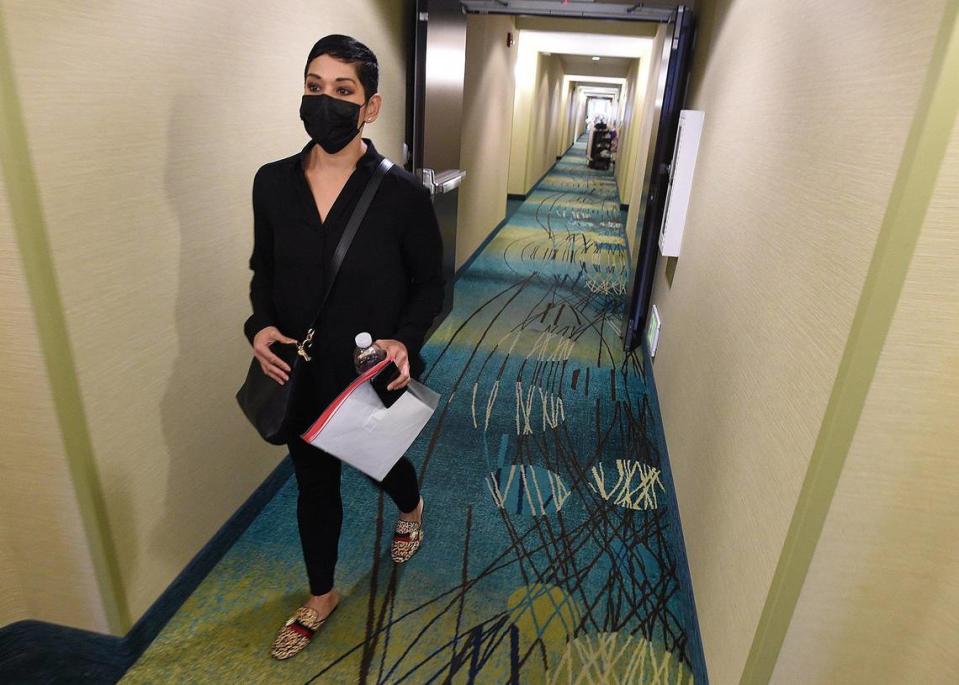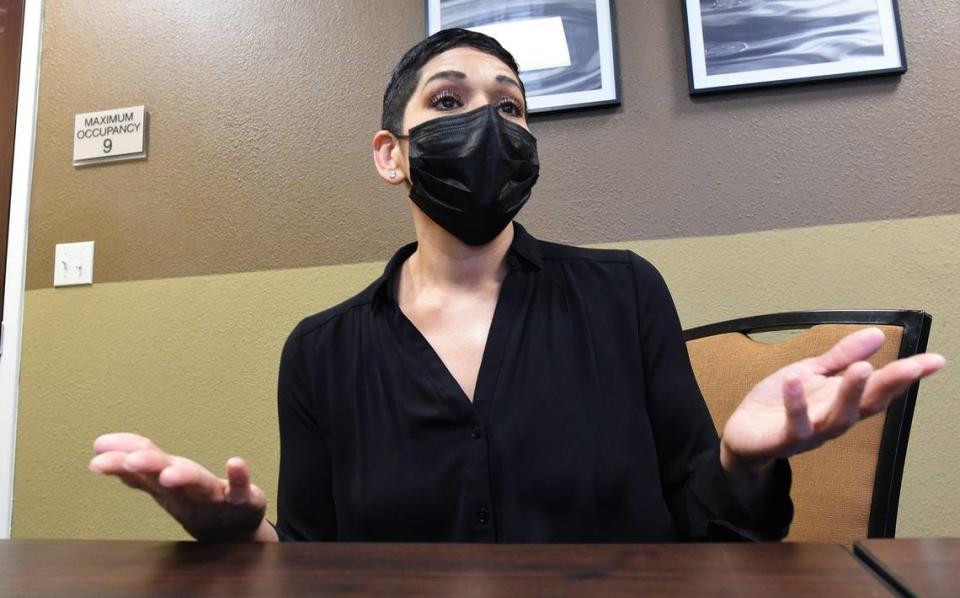Fresno County home sales skyrocketed during pandemic. See how renters were affected
Randi Gonzales and her family were racing against the clock once they learned the Fresno home they rented for nearly 38 years was being sold.
Time ran out before they could find somewhere else to live, so they moved into a hotel, and their belongings went to storage.
Gonzales, her mother, her two daughters and two grandchildren lived in a home by Fresno High owned by her mother’s long-time boyfriend who lived at another property. Legal documents show that, after the property owner died in late 2019, his relative initially promised the family they could keep the house but, in 2020, decided to sell the property.
Gonzales’ family was left scrambling.
“We must’ve called every apartment complex in town, and there was nothing available because the moratorium was in place,” she said. “Even so, every apartment complex told us there was a waiting list six months to a year out, and we didn’t have that kind of time.”
In December 2020, the family received a 60-day notice to vacate the property. After working with Central California Legal Services, they were able to come to an agreement that allowed them to leave the home by May 31, 2021, without the case going to court or an eviction on their record. They also received $10,000 from the new property owner, but with no rental on the horizon, they checked into a hotel which quickly drained the money.
Since June, the family of six and their dog have lived in a hotel room with two full-sized beds and a pull-out couch, paying roughly $1,000 a week. They’ve been searching for more stable housing to no avail.
“If it was just adults, me and my mom and my two adult daughters, it would be tough, but we could manage,” Gonzales said. “But we have my two grandkids. They have been asking every day for the last, definitely the last two months, ‘When are we going to find a home? When are we going to move out of here?’”

Gonzales’ family was one of many Fresno families who were displaced during the pandemic, while the rental vacancy rate was very low and property owners took advantage of a soaring housing market.
The place Gonzales once called home has since been sold twice – in June 2021 for $230,000 and again in October of 2021 for $320,000, according to information from Zillow.
The Fresno Bee/Fresnoland analyzed Fresno County Sheriff lockout data and property sales on Zillow and Redfin to see how many residents were evicted during the eviction moratorium shortly before their landlord sold the property.
The moratorium banned evictions for nonpayment of rent; however, if landlords wished to sell their properties or if tenants violated the lease, evictions were allowed.
Rentals for sale
Single-family homes and condominiums made up more than 35% of the lockouts that took place during the pandemic eviction moratorium, roughly 341 rentals. About 25% of rentals in Fresno are single-family homes.
Of the rentals where lockouts occurred, 89 – around 9% of the total lockouts in Fresno County from March 2020 to September 2021 — were listed for sale or sold within six months of the lockout, according to Zillow and Redfin.
According to the data, 104 single-family homes and condos were sold within a year of a reported lockout. Some former rentals have been sold more than once since the pandemic began, according to Zillow and Redfin.
The Fresno Bee/Fresnoland was unable to confirm whether “intent to sell” was the reason listed for the 104 lockouts.
The Fresno Bee/Fresnoland’s data is likely an undercount of the displacement that took place during the pandemic due to home sales as it does not capture displacement of those who were able to resolve the case outside of court but were still displaced, which was the case for Gonzales.
It also doesn’t include information on how many renters were evicted because the landlord said they intended to sell but never did – something that Robert Cortes, housing supervising attorney for the Central California Legal Services, said was a loophole in the eviction moratorium.
Cortes said he has seen, since the pandemic, many evictions where the landlord states an intent to remove the property from the rental market. “The way the law is written,” Cortes said, “a landlord only has to make that allegation.”
Cortes explained that if a landlord then rents the property out again once the renter is removed, the burden falls on the renter to prove that the landlord did not actually intend to sell the property.
“There really isn’t any moratorium, at best there are some protections for very limited and narrow areas for housing laws,” Cortes said. “And there are huge loopholes that landlords can exploit.”
Home sales skyrocketed after shelter-in-place orders
The increase in home sale prices has led many homeowners, both owner-occupants and landlords, to sell during the pandemic.
Steve Flach, president of the Fresno Association of Realtors, said home sales saw an uptick shortly after the shelter-in-place orders were issued and that “demand hasn’t really let off.”
“Home became much more significant to people,” Flach said. “It was your office; it was a classroom; it was your playground; I mean your home and your living area became pretty much everything.”
Driven by a high demand and an already low supply, the median sale price of a home in Fresno County jumped more than 38% from December 2019 to December 2021, Flach said.
“We’ve been seeing a shortage of inventory here in Fresno County for the past several years,” Flach said. “I would say, back to about 2016, it’s been a tight inventory, and then when COVID and shelter-in-place hit, that just magnified things.”
In December 2019, there were more than 1,400 homes on the market and 752 recorded home sales, according to Flach. Two years later, there were around 650 homes on the market and 759 sales.
“With that type of activity,” Flach said, “values just skyrocketed.”
Flach said that an influx of out-of-town homebuyers, coming from pricier markets like the Bay Area and Los Angeles, contributed to further depletion of available housing in the local market.
There is no data available on how many landlords in Fresno County sold their properties during the pandemic; however, Flach said that statewide, only about 9.5% of homes purchased in 2021, including homes bought for a flip and then turned into owner-occupied homes, was set to be used as investment properties – a record low in the past decade.
Flach said many landlords selling their property fell into one of two groups – larger investment groups selling local properties and buying out of state or mom-and-pop landlords who couldn’t afford their bills without monthly rent coming in from tenants.

Challenges in finding rentals during the pandemic
For Gonzales and her mother, avoiding a formal eviction was a small win, but the challenges did not end there.
She said the family initially planned to buy a home, but the rushed timeline and skyrocketing prices in the housing market led them to search for another rental. However, limited supply ultimately pushed them into a hotel.
“Every single day, we have been looking, and there’s just nothing available,” Gonzales said.
According to U.S. Census Data, only 0.7% of all rental units were vacant in Fresno in the second quarter of 2020; it was 1.4% in the third quarter of 2021.
Amid their ongoing search for housing, Gonzales said they have run into scams, stereotypes, and steep rental prices.
“I’ve had owners of homes direct me to homeless shelters … We don’t have a problem with paying the rent,” Gonzales said of her quadruple-income family. “The problem is there is no housing.”
Gonzales said she felt that several landlords turned her family away because they are living in a hotel and that they may be able to find housing if “people could just get past that.” Other times when the family felt they had a promising lead on a rental, it turned out to be an online scam.
“People have asked us, ‘Is there really nowhere to go?’” Gonzales said. “We wouldn’t be here if we didn’t have to be.”

